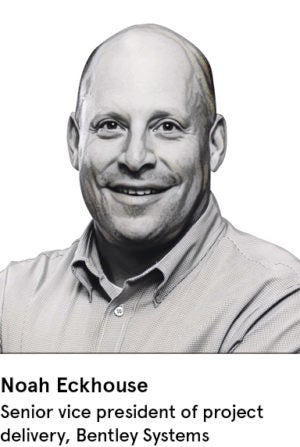 Digital data has allowed contractors to create 3D models of projects in advance to phase and co-ordinate the physical elements and timing of a project. Now digital twins, or a live model of assets, processes, people and places, as well as systems and devices, enable real-time feedback during design, construction and operation, which takes project development into a new era.
Digital data has allowed contractors to create 3D models of projects in advance to phase and co-ordinate the physical elements and timing of a project. Now digital twins, or a live model of assets, processes, people and places, as well as systems and devices, enable real-time feedback during design, construction and operation, which takes project development into a new era.
“As construction moves from phase to phase, handover can often mean that data and project insights are lost,” says Noah Eckhouse, senior vice president of project delivery with Bentley Systems. “The use of a digital-twin approach allows contractors across the supply chain to harvest existing project data, add to it and make it actionable for later stages of the project delivery process.”
Bentley Systems has been at the forefront of this evolution and this year launched a Going Digital campaign to achieve the industrialisation of construction. Going Digital is intended to industrialise project delivery, leverage digital DNA and accelerate a user’s digital advancement. Bentley also announced the integration of a range of technologies, acquisitions and partnerships to achieve this, signalling the mainstreaming of the digital twin.
This integration consists of cloud computing with Siemens, through the iTwin project, city planning and web-based 3D visualisation through Bentley’s Agency9, workflow management with Microsoft Flow, as well as a partnership with Atos. Leveraging ProjectWise, with AssetWise, MicroStation, PlantSight, iModel and more, Bentley is bringing the digital twin to all.
There are three steps to going fully digital. First is the automation of BIM (building information modelling) processes, making them consistent, repeatable and scalable. Second is the leveraging of digital DNA and this means integrating information that exists, but is not accessible. This could be engineering and physical, even geological, data.
Third, by accelerating digital advancement for all project participants, project development and operations can be transformed. During the building of China’s Tianjin Bridge, digital management of information resolved 120 issues and prevented 624 collisions, resulting in around 5 per cent savings in project costs and a 10 per cent reduction in construction time. When cost and time are the key issues in a construction project, the ability to manage these elements provides a strong competitive edge.
This is why infrastructure asset owners and their teams have recognised the potential of digital advancements. To realise the potential though, more than just digital representation is required. A digital twin must also have practical solutions for their synchronisation to changing actual conditions in the real world and be able to synchronise an asset’s physical reality with engineering or virtual data.
Historically engineering information has often been unavailable or out of date. It can be an assortment of effectively inaccessible dark data in either opaque engineering files or unintelligent document formats.
Bentley has now surmounted these challenges, with the confluence of its reality modelling, iModelHub, Connected Data Environment and web-visibility technologies. By bringing another dimension into play, predictive analytics and operations over time, the construction industry really becomes 4.0.
Once construction meets technology, even the shape of the industry will change, with a focus on service rather than assets. The potential for infrastructure as a service is the next logical step.
Perhaps the best way to think about the impact of digital on construction comes from Peter Ruff, head of BIM for the Skanska Costain Strabag JV (SCS), responsible for HS2 main works lots 1 and 2. Using Bentley Systems’ ProjectWise platform, the team say they could analyse key designs in 75 per cent less time and change the design itself in 50 per cent less time, with the changes synchronised everywhere. Mr Ruff says of ProjectWise: “You wouldn’t do a project now without it. It would be absolute chaos.”
For more information please visit www.bentley.com

